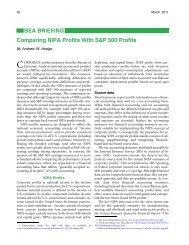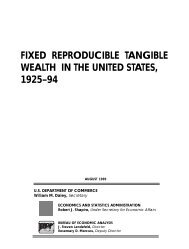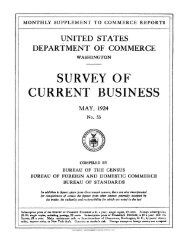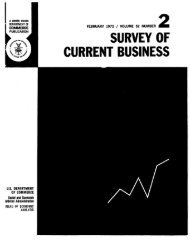the BUSINESS SITUATION - Bureau of Economic Analysis
the BUSINESS SITUATION - Bureau of Economic Analysis
the BUSINESS SITUATION - Bureau of Economic Analysis
Create successful ePaper yourself
Turn your PDF publications into a flip-book with our unique Google optimized e-Paper software.
J. HE business expansion continued<br />
through October and appeared to be<br />
as robust as ever. Total wages and<br />
salaries showed <strong>the</strong> largest monthly<br />
advance <strong>of</strong> <strong>the</strong> year as employment,<br />
hours <strong>of</strong> work, and rates <strong>of</strong> pay increased.<br />
The strong demand for labor<br />
brought about ano<strong>the</strong>r decline in unemployment.<br />
Despite <strong>the</strong> large cutback<br />
in steel output, industrial production<br />
increased following a dip in September.<br />
Retail sales rose to a new peak.<br />
Rising outlays by business for new<br />
plant and equipment, increasing government<br />
purchases <strong>of</strong> goods and services<br />
and <strong>the</strong> recent increases in Social<br />
Security payments are providing <strong>the</strong><br />
main stimulus to <strong>the</strong> advance this fall.<br />
So far at least, <strong>the</strong>ir effects on income,<br />
production, and sales outweigh <strong>the</strong><br />
dampening influences <strong>of</strong> <strong>the</strong> adjustment<br />
in steel by a good margin.<br />
Payrolls up sharply<br />
Reflecting gains in a broad range <strong>of</strong><br />
industries, payrolls rose $3 billion at<br />
an annual rate from September to<br />
October. Business and property income<br />
also advanced—by about $1<br />
billion—but transfer payments, which<br />
jumped $10.6 billion (annual rate) in<br />
September because <strong>of</strong> <strong>the</strong> lump-sum<br />
retroactive payment <strong>of</strong> <strong>the</strong> Social<br />
Security increase, fell back by $9.5<br />
billion. As a result, total personal<br />
income declined $5.7 billion; however,<br />
if <strong>the</strong> lump-sum payment is excluded<br />
from <strong>the</strong> September total, <strong>the</strong> October<br />
change was an increase <strong>of</strong> approximately<br />
$5 billion.<br />
The increase in total wages and<br />
salaries was divided about equally<br />
<strong>the</strong> <strong>BUSINESS</strong> <strong>SITUATION</strong><br />
among manufacturing, nonmanufacturing,<br />
and government. It was due in<br />
part to a seasonally adjusted employment<br />
rise <strong>of</strong> about 225,000 (according<br />
to preliminary figures) in nonagricultural<br />
establishments—<strong>the</strong> largest<br />
gain since early summer. In most<br />
Billion $<br />
70<br />
60<br />
55<br />
50<br />
30<br />
15<br />
Construction Expenditures<br />
Private Residential<br />
CHART 1<br />
10 I I I I I I I I I I I I I I I I I I I<br />
1961 1962 1963 1964 1965<br />
Quarterly, Seasonally Adjusted, at Annual Rates<br />
Data: Census<br />
U.S. Department <strong>of</strong> Commerce, Office <strong>of</strong> Business <strong>Economic</strong>s 65-11-1<br />
manufacturing industries, employment<br />
and weekly hours <strong>of</strong> work both rose,<br />
with increased overtime hours <strong>of</strong> some<br />
importance. Almost half <strong>of</strong> <strong>the</strong> large<br />
advance in government payrolls reflected<br />
a pay raise for Federal civilian<br />
workers; <strong>the</strong> rest, increases associated<br />
with <strong>the</strong> war in Vietnam and rising<br />
State and local employment.<br />
October marked <strong>the</strong> first month <strong>of</strong><br />
<strong>the</strong> regular 7-percent (average) increase<br />
in Social Security benefits. This rise,<br />
which permanently affects <strong>the</strong> level <strong>of</strong><br />
income, added $1.1 billion to <strong>the</strong><br />
October income flow.<br />
Industrial production higher<br />
Industrial production rose about onehalf<br />
<strong>of</strong> 1 percent last month as increases<br />
in most durable goods industries<br />
<strong>of</strong>fset a sharp decrease in steel.<br />
Steel output fell about 10 percent after<br />
seasonal adjustment for <strong>the</strong> third<br />
straight month <strong>of</strong> decline. The cutback<br />
from <strong>the</strong> July peak has now<br />
amounted to 25 percent, slightly more<br />
than <strong>the</strong> overall reduction that occurred<br />
in <strong>the</strong> 1963 steel inventory adjustment.<br />
Weekly figures for late October and <strong>the</strong><br />
first 2 weeks in November suggest that<br />
<strong>the</strong> rate <strong>of</strong> decline has diminished.<br />
With consumption strong and steel<br />
production falling, manufacturing consumers<br />
are now liquidating <strong>the</strong> large<br />
inventories <strong>of</strong> steel <strong>the</strong>y accumulated<br />
over <strong>the</strong> year. At <strong>the</strong> end <strong>of</strong> September,<br />
<strong>the</strong>se stocks totaled 17.0 million tons,<br />
some 7K million more than <strong>the</strong> carryover<br />
<strong>of</strong> a year earlier. The reduction in September,<br />
<strong>the</strong> first in 16 months, was<br />
only 200,000 tons, but it is quite likely<br />
that a much larger reduction took place<br />
in October.







